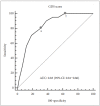Clinical Usefulness of the Geriatric Depression Scale to Identify the Elderly at Risk of Suicide
- PMID: 32403208
- PMCID: PMC7265027
- DOI: 10.30773/pi.2019.0299
Clinical Usefulness of the Geriatric Depression Scale to Identify the Elderly at Risk of Suicide
Abstract
Objective: Population-based suicidal screening can be an important intervention method to reduce suicidal attempt rate in community. However, directly asking about suicidal behavior may be burdensome to non-mental health workers. This study aimed to evaluate the clinical usefulness of the Geriatric Depression Scale-15 (GDS-15) in identifying the elderly at risk of suicide in community.
Methods: Nine hundred forty-eight over 60 years of age participated in this study. All participants completed the GDS-15. A trained interviewer interviewed each participant for suicidality including suicidal ideation, plan, and prior attempt using the Structured Clinical Interview for DSM-IV.
Results: When the cut-off score of 10 in the GDS-15 was applied to identify the elderly at risk of suicide, the proportion of directly asking about suicidal behavior by non-mental health workers was reduced by 33.1%; however, 19.5% at risk of suicide were missed. When the cut-off was changed to 6, 100% at risk of suicide were covered by the GDS-15.
Conclusion: Screening for suicidality using GDS-15 is a promising way to reduce the proportion of directly asking about suicidal behavior by non-mental health workers among the high-risk suicidal elderly in a community setting.
Keywords: Elderly; Geriatric Depression Scale; Screening; Suicide.
Conflict of interest statement
The authors have no potential conflicts of interest to disclose.
Figures

Similar articles
-
Does the geriatric depression scale (GDS) distinguish between older adults with high versus low levels of suicidal ideation?Am J Geriatr Psychiatry. 2005 Oct;13(10):876-83. doi: 10.1176/appi.ajgp.13.10.876. Am J Geriatr Psychiatry. 2005. PMID: 16223966
-
The development of a brief screening instrument for depression and suicidal ideation for elderly: the Depression and Suicide Screen.Psychiatry Clin Neurosci. 2005 Dec;59(6):634-8. doi: 10.1111/j.1440-1819.2005.01429.x. Psychiatry Clin Neurosci. 2005. PMID: 16401236
-
Agitated "unipolar" depression re-conceptualized as a depressive mixed state: implications for the antidepressant-suicide controversy.J Affect Disord. 2005 Apr;85(3):245-58. doi: 10.1016/j.jad.2004.12.004. J Affect Disord. 2005. PMID: 15780694
-
Measuring suicide risk in the elderly with non-institutionalized depression: an integrative review.Rev Bras Enferm. 2020 Oct 23;73(suppl 3):e20200106. doi: 10.1590/0034-7167-2020-0106. eCollection 2020. Rev Bras Enferm. 2020. PMID: 33111806 Review. English, Portuguese.
-
Association Between Atopic Dermatitis and Suicidality: A Systematic Review and Meta-analysis.JAMA Dermatol. 2019 Feb 1;155(2):178-187. doi: 10.1001/jamadermatol.2018.4566. JAMA Dermatol. 2019. PMID: 30540348 Free PMC article.
Cited by
-
Impact of Physical Activity on Anxiety, Depression, Stress and Quality of Life of the Older People in Brazil.Int J Environ Res Public Health. 2023 Jan 8;20(2):1127. doi: 10.3390/ijerph20021127. Int J Environ Res Public Health. 2023. PMID: 36673880 Free PMC article.
-
Bootstrapping semi-supervised annotation method for potential suicidal messages.Internet Interv. 2022 Feb 28;28:100519. doi: 10.1016/j.invent.2022.100519. eCollection 2022 Apr. Internet Interv. 2022. PMID: 35281704 Free PMC article. Review.
References
-
- Korean National Statistics. Available at: http://www.nso.go.kr. 2016. Accessed December 1, 2018.
-
- Zalsman G, Hawton K, Wasserman D, van Heeringen K, Arensman E, Sarchiapone M, et al. Suicide prevention strategies revisited: 10-year systematic review. Lancet Psychiatry. 2016;3:646–659. - PubMed
-
- Coppens E, Van Audenhove C, Iddi S, Arensman E, Gottlebe K, Koburger N, et al. Effectiveness of community facilitator training in improving knowledge, attitudes, and confidence in relation to depression and suicidal behavior: results of the OSPI-Europe intervention in four European countries. J Affect Disord. 2014;165:142–150. - PubMed
Grants and funding
LinkOut - more resources
Full Text Sources

